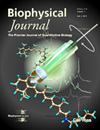染色质的动力学特性提供了对关键折叠原理的见解
IF 3.1
3区 生物学
Q2 BIOPHYSICS
引用次数: 0
摘要
尽管染色质的三维静态组织被高度研究,但染色质是一个动态结构,其时间依赖性变化对生物功能至关重要。虽然已知染色质内相互作用和环挤压对理解染色质组织至关重要,但它们各自在决定空间和时间组织性质方面的作用尚不清楚。通过模拟具有主动环挤压和染色质内相互作用的模型,我们发现在一定条件下,可测量的动态量由环挤压主导,尽管种群平均接触图(结构)可能由染色质内相互作用主导,而环挤压不起主要作用。我们的研究结果表明,环形挤压的动态标度指数与实验观察结果一致,与现有的分形-球模型预测的结果有很大不同。我们认为需要同时测量结构和动力学来明确地解释染色质的组织。本文章由计算机程序翻译,如有差异,请以英文原文为准。
Dynamical properties of chromatin provide insights into key folding principles
Even though the three-dimensional static organization of chromatin is highly studied, chromatin is a dynamic structure, and time-dependent changes are crucial for biological function. While it is known that both intra-chromatin interaction and loop extrusion are crucial to understanding chromatin organization, what their respective roles are in deciding the nature of spatial and temporal organization is not clear. Simulating a model with active loop extrusion and intra-chromatin interactions, we show that under certain conditions, the measurable dynamic quantities are dominated by the loop extrusion, even though the population-averaged contact map (structure) can be dominated by intra-chromatin interactions, with loop extrusion playing no major role. Our results show that the dynamic scaling exponents with loop extrusion are consistent with the experimental observations and can be very different from those predicted by existing fractal-globule models for chromatin. We argue that one needs to measure both the structure and dynamics simultaneously to unambiguously interpret the organization of chromatin.
求助全文
通过发布文献求助,成功后即可免费获取论文全文。
去求助
来源期刊

Biophysical journal
生物-生物物理
CiteScore
6.10
自引率
5.90%
发文量
3090
审稿时长
2 months
期刊介绍:
BJ publishes original articles, letters, and perspectives on important problems in modern biophysics. The papers should be written so as to be of interest to a broad community of biophysicists. BJ welcomes experimental studies that employ quantitative physical approaches for the study of biological systems, including or spanning scales from molecule to whole organism. Experimental studies of a purely descriptive or phenomenological nature, with no theoretical or mechanistic underpinning, are not appropriate for publication in BJ. Theoretical studies should offer new insights into the understanding ofexperimental results or suggest new experimentally testable hypotheses. Articles reporting significant methodological or technological advances, which have potential to open new areas of biophysical investigation, are also suitable for publication in BJ. Papers describing improvements in accuracy or speed of existing methods or extra detail within methods described previously are not suitable for BJ.
 求助内容:
求助内容: 应助结果提醒方式:
应助结果提醒方式:


